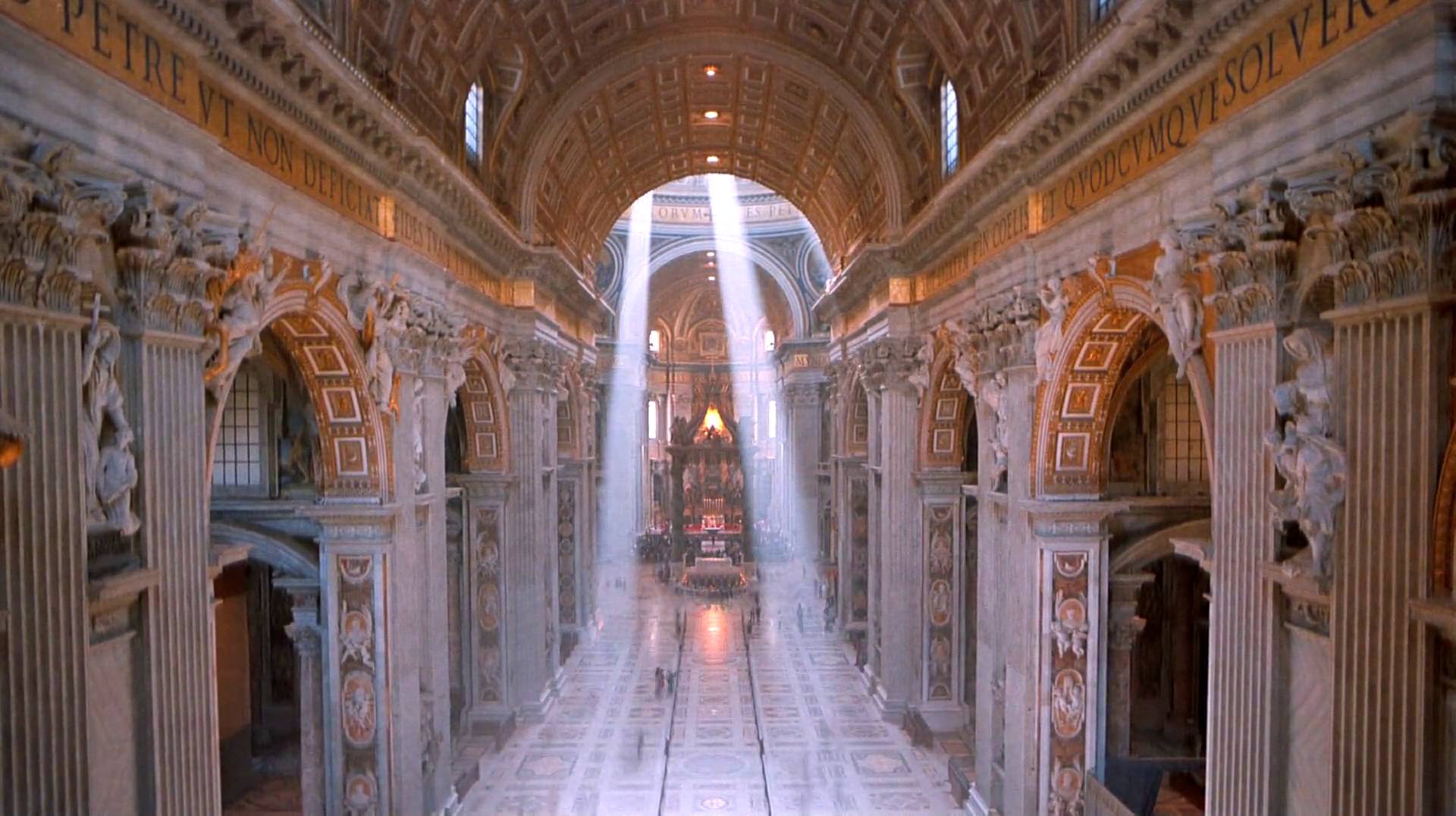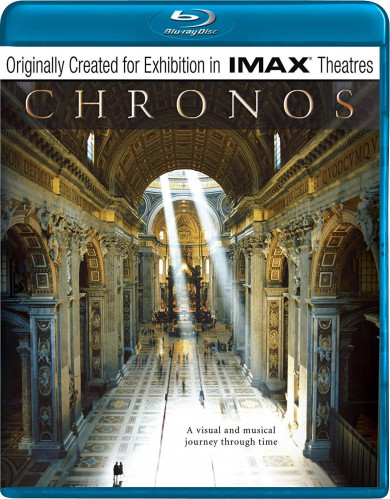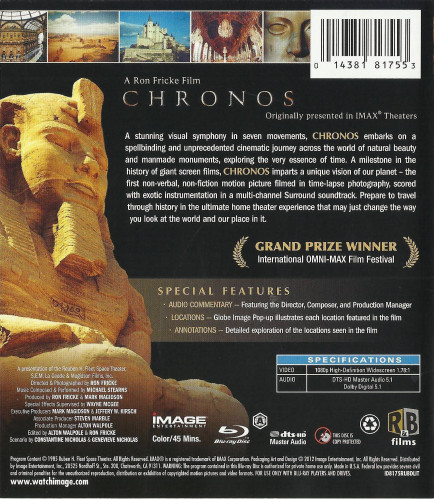IMAX: CHRONOS [1985 / 2012] [Blu-ray] [USA Release] A Visual and Musical Journey Through Time! Originally Created for Exhibition in IMAX Theatres!
A stunning visual symphony in seven movements, ‘CHRONOS’ embarks on a spellbinding and unprecedented cinematic journey across the world of natural beauty and manmade monuments, exploring the very essence of time. A milestone in the history of giant screen films, ‘CHRONOS’ imparts a unique vision of our planet and the first non-verbal, non-fiction motion picture filmed in time-lapse photography, scored with exotic instrumentation in a multi-channel Surround soundtrack. Prepare to travel through history in the ultimate Home Theatre experience that may just change the way you look at the world and our place in it. It won the GRAND PRIZE WINNER at the International OMNI-MAX Film Festival.
FILM FACT: The name of the film comes from the Ancient Greek word χρÏŒνος, krònos, which means time and is also the source too many modern terms related to time, such as chronology, synchronous etc. Michael Stearns, while composing the soundtrack for the film, used a custom-made instrument called "The Beam" to generate many of the sounds he required. The Beam was 12 feet (3.7 m) long, made of extruded aluminium with 24 piano strings of gauge 19-22. Ron Fricke designed and built a 65 mm camera for the film, which included a motion control system for the film's cinematography. The director also used the system in his later films.
Director: Ron Fricke
Producers: Jeffrey Kirsch, Mark Magidson, Preston Fleet and Ron Fricke
Screenplay: Constantine Nicholas and Genevieve Nicholas
Composer: Michael Stearns
Cinematography: Ron Fricke (Director of Photography)
Image Resolution: 1080p (Technicolor)
Aspect Ratio: 1.78:1 [IMAX OMNIMAX]
Audio: 5.1 Dolby Digital Audio
5.1 DTS-HD Master Audio
English: 5.1 Dolby Digital Audio [Audio Commentary]
Subtitles: None
Running Time: 42 minutes
Region: All Regions
Number of discs: 1
Studio: IMAGE ENTERTAINMENT
Andrew’s Blu-ray Review: IMAX: ‘CHRONOS’ [1985] was filmed in 70mm IMAX, and ‘CHRONOS’ is a photographic travel experience to some of the most awe-inspiring locations, cultural monuments and natural formations found throughout planet Earth. Capturing some breath-taking visuals in crystal clear detail and editing the collection of long and sometimes uninterrupted stationary filming in time-lapse, director Ron Fricke takes the audience on an unforgettable exploration of some of our planet’s most intriguing sights that is awe inspiring. The IMAX film works from juxtaposition by turns shocking, bizarre and gorgeous: so a room of skulls bounce up against the terracotta army; a felled tree contrasts with battery farming; burning oil wells blend with bouncing African tribal rituals; a monkey in a hot spring is followed by an astonishing sequence of massed arm-waving from somewhere Oriental.
IMAX: ‘CHRONOS’ is an abstract film directed by Ron Fricke, created with custom-built time-lapse cameras and originally released in IMAX theatres. IMAX: ‘CHRONOS’ is 43 minutes long and has no actors or dialogue. The soundtrack consists of a single continuous piece by composer Michael Stearns. Filmed in dozens of locations in five continents, and the film relates to the concept of time passing on different scales and the bulk of the IMAX film covers the history of civilization, from pre-history to Egypt to Rome to late Antiquity to the rise of Western Europe in the Middle Ages to the Renaissance to the modern era. It centres on European themes but not exclusively. Other time scales include the passing of seasons, and the passing of night and day, and the passing shadows of the sun in an afternoon to the passing of people on the street. These themes are intermingled with symbolic meaning.
IMAX: ‘CHRONOS’ shares its particular style with the film ‘Koyaanisqatsi’ [1983], for which Ron Fricke was the cinematographer, as well as his later films ‘Sacred Site’ and ‘BARAKA’ [1992]. The theme of the film is "the celebration of life", and does not include the themes of technology as the culprit for society or "life out of balance", which were present in ‘Koyaanisqatsi.’ American Cinematographer described the film as "a musical poem praising the evolution of Western man from Cairo to Los Angeles." The film was produced by Canticle Films, a production company founded by Ron Fricke. Funding for IMAX: ‘CHRONOS’ came from the money acquired through the publicity surrounding the production of ‘Koyaanisqatsi.’
To fully take-in the magnitude of the visuals with all aspect of IMAX films, that really demands to be viewed on a large LCD 3D Widescreen Television. Watching the film in that manner offers an experience that can only be actually taking an expensive trip around the world to see the sites first-hand; and do it all with a set of headphones to block out the disturbances and just meditate on some of our cultural landmarks, habits, and the planet’s natural wonders.
Ron Fricke designed and built the 65 mm camera for the IMAX film, which included a motion control system for the film's cinematography. Director Ron Fricke also used the system in his later IMAX films. Michael Stearns, while composing the soundtrack for the IMAX film, used a custom-made instrument called "The Beam" to generate many of the sounds he required. The Beam was 12 feet (3.7 m) long, made of extruded aluminium with 24 piano strings of gauge 19-22. The name of the film comes from the Ancient Greek word χρÏŒνος, krònos, which means time and is also the source too many modern terms related to time, such as chronology, synchronous etc. Also Composer Michael Stearns does a wonderful job of mix-and-matching the music to fit, at one point mashing up Kodo drums and bagpipes, though a directorial commentary would have been a good idea to help us sort out a complex 13-month, 24-country saga.
IMAX: ‘CHRONOS’ Filming Locations were Monument Valley, Arizona, USA; Abbaye, Mont Saint-Michel, Manche, France; Crystal Cathedral at 12141 Lewis Street, Garden Grove, California, USA; 405 Freeway, Los Angeles, California, USA; Abu Simbel, Egypt; Acropolis, Athens, Greece; Alcázar de Segovia, Segovia, Castilla y León, Spain; Arc de Triomphe, Paris 8, Paris, France; Beverly Center at 8500 Beverly Blvd., Los Angeles, California, USA; Canyon de Chelly National Monument, Chinle, Arizona, USA; Cape Canaveral, Florida, USA; Catedral de Toledo, Toledo, Castilla-La Mancha, Spain; Cathédrale Notre Dame de Reims, Reims, Marne, France; Century City, Los Angeles, California, USA; Chateau de Versailles, Versailles, Yvelines, France; Château de Chambord, Chambord, Loir-et-Cher, France; Downtown, Los Angeles, California, USA; Ellis Island, New York Harbor, New York City, New York, USA; Florence, Tuscany, Italy; Galleria Vittorio Emanuele II, Piazza del Duomo, Milan, Lombardia, Italy; Giza Plateau, Giza, Egypt; Grand Canyon National Park, Arizona, USA; Grand Central Station, Manhattan, New York City, New York, USA; Karnak, Egypt; La Chapelle, Paris 10, Paris, France; Lake Powell, Utah, USA; Luxor, Egypt; Manhattan, New York City, New York, USA; McGraw-Hill Building at 330 West 42nd Street, Manhattan, New York City, New York, USA; Milan, Lombardia, Italy; Monument Valley, Utah, USA; Musée du Louvre, Paris 1, Paris, France; Normandie, France; Notre Dame, Paris 1, Paris, France; Nunney Castle, Frome, Somerset, England, UK; Obelisk of Queen Hatshepsut, Karnak Temple, Luxor, Egypt; Old City, Jerusalem, Israel; Old Wardour Castle, Salisbury, Wiltshire, England, UK; Paris, France; Park Avenue, Manhattan, New York City, New York, USA; Place de la Concorde, Paris 8, Paris, France; Porte des Lilas, Le Métro, Paris, France; Pyramid of Khephren, Giza, Egypt; Ramasseum, Egypt; Roman Bathhouse, Pompeii, Naples, Campania, Italy; Rome, Lazio, Italy; Shiprock, New Mexico, USA; St. Peter Basilica, Vatican City; Statue of Liberty, Liberty Island, New York Harbor, New York City, New York, USA; Stonehenge, Salisbury Plain, Wiltshire, England, UK; Teatro alla Scala, Milan, Lombardia, Italy; Temple of Amun, Karnak Temple, Luxor, Egypt; Temple of Medinet Habu, Giza, Egypt; Temple of Queen Nefertari, Abu Simbel, Egypt; Temple of Ramesses II, Abu Simbel, Egypt; The Sphinx, Giza Plateau, Giza, Egypt; Thebes, Egypt; Times Square, Manhattan, New York City, New York, USA; Toledo, Castilla-La Mancha, Spain; Venice, Veneto, Italy and Westin Bonaventure Hotel & Suites at 404 S. Figueroa Street, Downtown, Los Angeles, California, USA.
Blu-ray Image Quality – IMAX: ‘CHRONOS’ is a stunning 1080p encoded image quality for a film released in 1985, as well as an equally impressive 1.78:1 aspect ratio. Most of the time it has excellent sharpness value with a good depth of field image prospective. It mostly has good contrast ratio with good black level, with no visible compression errors. The picture image is partly a bit soft and not always in High-Definition level. Some time-lapse photography looks a little shaky and restless from time to time. Like most IMAX-format films, ‘CHRONOS’ sports excellent clarity from corner to corner of the frame, readily showing the intricacies of rock formations, marble busts, and hectic cityscapes. The background shots usually have a good quality picture enhancement and the colours are quite natural. Colour holds up well, though, and you'll be pleased with the deep azure blues of the desert sky, the rusty terracotta hues of canyon walls, and the vivid, gilded interior of the Vatican. Black levels are adequately deep while still preserving plenty of detail in the shadows. Plus the close-ups are always of stunning quality to enhance your IMAX experience.
Blu-ray Audio Quality – IMAX: ‘CHRONOS’ is a film with only a music presentation that has two audio experiences, one in a 5.1 Dolby Digital Audio track, but you also have the choice of viewing the Blu-ray disc in an equally impressive and stunning 5.1 DTS-HD Master Audio track, which you experience some subtle nuisance of ambient sounds in your rear speakers. Michael Sterns synthesiser-heavy score will not be to everyone's taste, but it certainly has a grand presence on this track. Dynamic range is very "bright," but that fits Michael Stearn's choice of electronic instrumentation. High end remains clean and as pleasing as is possible, while low bass is deep enough that it has heft and presence but is not overpowering. The sense of presence in the rear speakers is very effective, and often a "wall of sound" is created that is quite enveloping. But when you get to Chapter 5 at around 23:33 seconds, all of your speakers really kick in with spectacular results, that also fits with the totally awesome and spectacular images you view at the same time, that will really impress your friends you invite round, as at that point you get to experience some really spectacular surround "wall of sound." Again, the film music score itself is an acquired taste, but pumped through a decent set of speakers, ‘CHRONOS’ can be a very immersive, and a wonderfully overpowering experience. It all works very well with the ambience of all your speaker set-up and you experience a wonderful good atmospheric sound experience that goes so well with equally impressive IMAX OMNIMAX film images.
Blu-ray Special Features and Extras:
Audio Commentary featuring Composer Michael Stearns, Production Manager Alton Walpole and Director Ron Fricke: With this screen-specific audio commentary, we are first introduced by Michael Stearns, who informs us that he composed the film music score for the film ‘CHRONOS’ over 17 year ago since the release of this IMAX Blu-ray disc, and to his left in the recording booth we are introduced to Alton Walpole, who couldn’t work out what his job was towards the IMAX film, but someone reminds him that he was the Production Manager, and the final person to introduce himself is the director Ron Fricke, who of course was the Director a Director of Photography for the IMAX film ‘CHRNOS.’ Because the IMAX film only runs to just over 42 minutes, I quite enjoyed this audio commentary track. At times it can be quite technical, but it still manages to feel somewhat breezy. None of the participants are pretentious, and there are some very humorous stories of trying to get complex shots taken in one take, including several times when the film almost nearly ran out in the camera, or an image needed to look "foggy," so Ron Fricke smoked "about fifty cigarettes" and blew them in front of the lens in order to generate some smoke to make the beam of light in one scene look more visible. Or about how not a single artificial light was used during the making of the film. My only complaint is that Ron Fricke never really discusses his own personal shot selection or why he assembled images together the way he did; whereas a bit more creative discussion would have been very welcome. Don't expect any discussion of Ron Fricke's theme scenario intentions, but if you're after production details, technical analysis, and travel anecdotes, this audio commentary track will suit you just fine. The three participates look back fondly on their visual creation, share plenty of laughs, and tell some really crazy stories, like when the camera operator had to load the film magazine in a dark Egyptian tomb because someone had left the changing bag in Cairo. When you get to Chapter 8 at around 39 minutes you get the shot of flying over the Pyramids in Egypt, and one of the commentators points out at the top of the first Pyramid you see a man in blue crouching down, who is not supposed to be there as it is illegal. This track is well worth a listen, especially as the IMAX OMNIMAX film runs for just over 42 minutes long.
Special Feature: Globe Image Pop-up: Globe Image Pop-up illustrates each location featured in the film. The tools with the “Locations Image Pop-up” are an important and very useful feature. Once activated a small globe appears on the bottom right hand corner so that always remains visible where you currently are. In addition to this feature, it is also still more about the respective Location Show. The respective text panels appear legibly and provided with partly quite detailed texts in the left corner and the text panels are available only in English. To view this special feature, you have to insert the Blu-ray disc into your DVD ROM Drive in your computer to view this additional information about the landscapes featured in the IMAX OMNIMAX film.
Special Feature: Annotations: This “Annotations” presents detailed information about each location viewed throughout the IMAX film. If you go to the pop-up menu and turn on "Annotations," a text-box filled with a few sentences worth of info will pop up in the lower left hand corner of the frame for every location in the film. Likewise, by selecting "Locations," a globe also appears on the lower right hand corner to show you where each scene is taking place in the film. To view this special feature, you have to insert the Blu-ray disc into your DVD ROM Drive in your computer to view this additional information about the landscapes featured in the IMAX OMNIMAX film.
Finally, IMAX: ‘CHRONOS’ is a total interesting and fascinating IMAX film. It may not be for everyone, but I found it very soothing, very thought-provoking and at times totally breath-taking and having no narration throughout the film, there is of course no need for one, as the stunning images speak for themselves. What would be inappropriate for documentation of a similar nature, works very well here in a totally excellent way, as Ron Fricke's time-lapse film is truly a fusion of stunning images and awesome sounds on a grand scale. The composed music of Michael Stearns style is similar to the music of Vangelis which of course was responsible for the soundtrack of 'Blade Runner' and '1492,' and is accordingly relaxed and therefore in a 1980s-moderate synthesizer-style, and is entirely appropriate to the respective stunning images you view which is timeless. The whole ambience thing is the way things are blended perfectly to all speakers and the result is a great sound carpet let the sometimes spectacular recordings appear fantastic. Again, the material may not be to everyone's taste, but to me personally IMAX: ‘CHRONOS’ remains a totally unique IMAX experience that it is well worth checking out in 1080p high-definition, even though you only view the film on your Home Cinema screen. In the end, the IMAX: ‘CHRONOS’ film is totally impressive, especially more for its achievement as a piece of remarkable and innovative cinematography than as a piece of cinema, overshadowed as it is by both ‘Koyaanisqatsi’ and ‘Baraka’ which were also directed by Ron Fricke’s IMAX films, where he would be more successfully in his pursuit of more spiritual power of the worldwide locations Ron Fricke encountered on his travels with the people who live in those locations, and has produced something totally magical for the IMAX cinema, and to really appreciate this cinema masterpiece, it should really be viewed via an IMAX cinema screen, but despite this, I am still glad I have the IMAX: ‘CHRONOS’ film in my ever increasing IMAX Blu-ray Collection. Very Highly Recommended!
Andrew C. Miller – Your Ultimate No.1 Film Aficionado
Le Cinema Paradiso
United Kingdom



